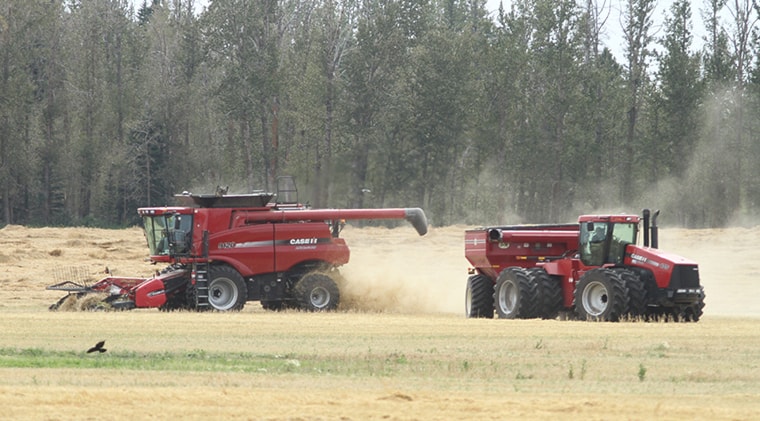Combine sightings are on the rise in Central Alberta, as continued warm, dry weather hastens the ripening of crops.
A report issued by Agriculture Financial Services Corp. (AFSC) last week estimated that 11 per cent of Central Alberta’s crops had been swathed and four per cent combined.
Harry Brook, an Alberta Agriculture and Rural Development crop specialist at the department’s Ag-Info Centre in Stettler, said Wednesday that the figure for swathing could now be as high as 30 per cent. Combining, he added, has yet to really get underway in this region.
“Around Stettler there’s only about one field I’m aware of that’s been harvested.”
Many of those swathing are doing so to hasten the drying of green seeds, and thereby even out the ripening of crops.
Another strategy being used is to spray fields with chemicals like glyphosate, which dry out the plants so that they can be straight-combined.
Regardless, said Brook, the threat of frost damage diminishes with the passage of each warm day.
“I’m thinking by the end of next week we’ll be fairly safe with the majority of the crop,” he said, explaining that the adverse impact of freezing temperatures drops with the seeds’ moisture content.
The AFSC report projected that crop yields in Alberta could be 10 to 15 per cent above long-term averages. Brook concurred, but cautioned that nothing is certain until harvest concludes.
“Don’t count your chickens before they hatch and don’t count your grain until it’s in the bin. And even then, don’t forget about it, because you still have to worry about storage issues.”
Last year, he pointed out, canola crops looked promising going into harvest but suffered from unexpected damage due to aster yellows and wind-blown swaths.
“All you need is a wet spell, and all of a sudden you have grade problems,” added Brook.
Many producers were hurt by hail this year, with claims in Alberta well above average. But the storms tended to be localized.
“It gets down to where one neighbour got no hail damage and the next guy lost 50 per cent or all of his crop.”
Similarly, bertha armyworm infestations hit some canola fields hard and missed others, said Brook.
He noted that many of the worms succumbed to viral infections and bacterial disease — a welcome consequence of the moist and humid conditions early in the growing season.
That same weather wreaked havoc on many hay crops, however. Farmers were forced to postpone cutting, with a resulting decline in quality.
That moisture has now disappeared, but with the exception of those planning for fall-seeded crops like winter wheat, this shouldn’t be a concern for farmers, said Brook.
“I don’t think you’ll see any draught-related maturity issues.
“Our surface moisture is pretty much used up, but the crop is done as well.”
Meanwhile, recent hot weather in parts of the United States is expected to diminish soybean production.
“That’s definitely supported our canola prices,” said Brook.
Cereal crop prices are being pulled down by a big corn crop to the south, but producers here should still earn decent profits thanks to the anticipated high yields.
hrichards@www.reddeeradvocate.com
